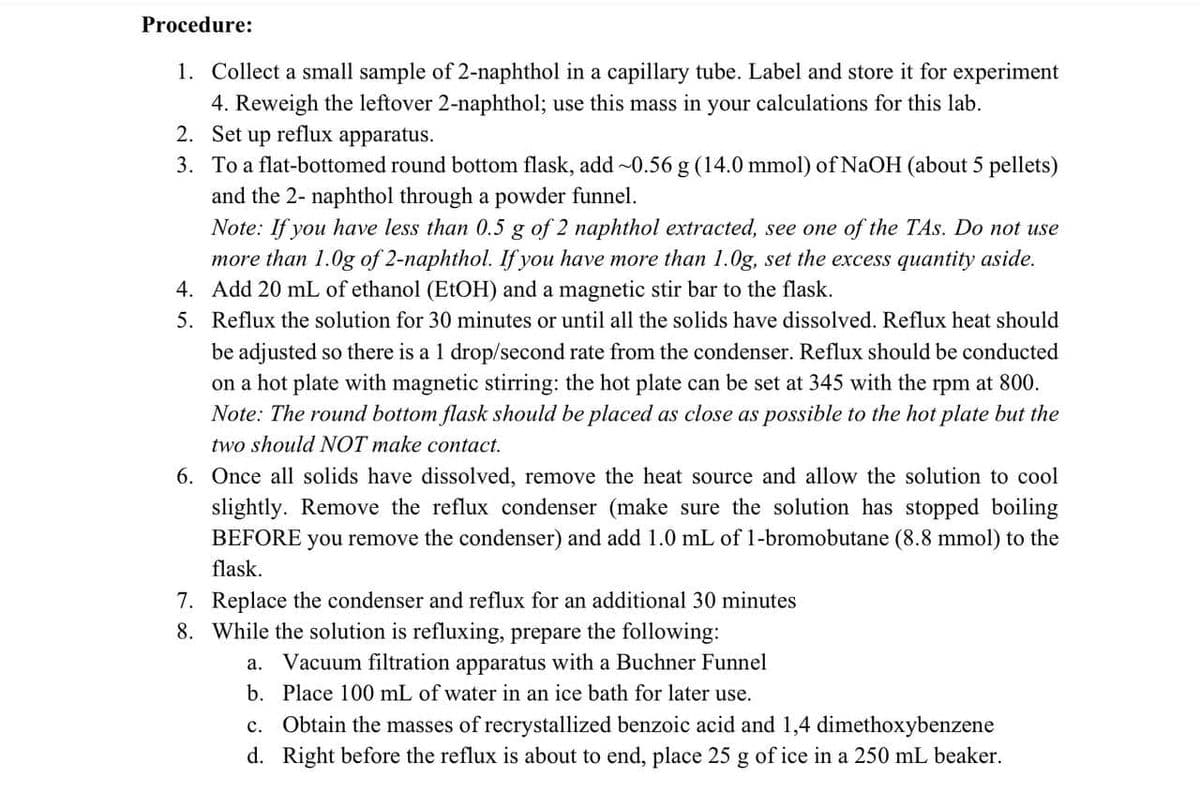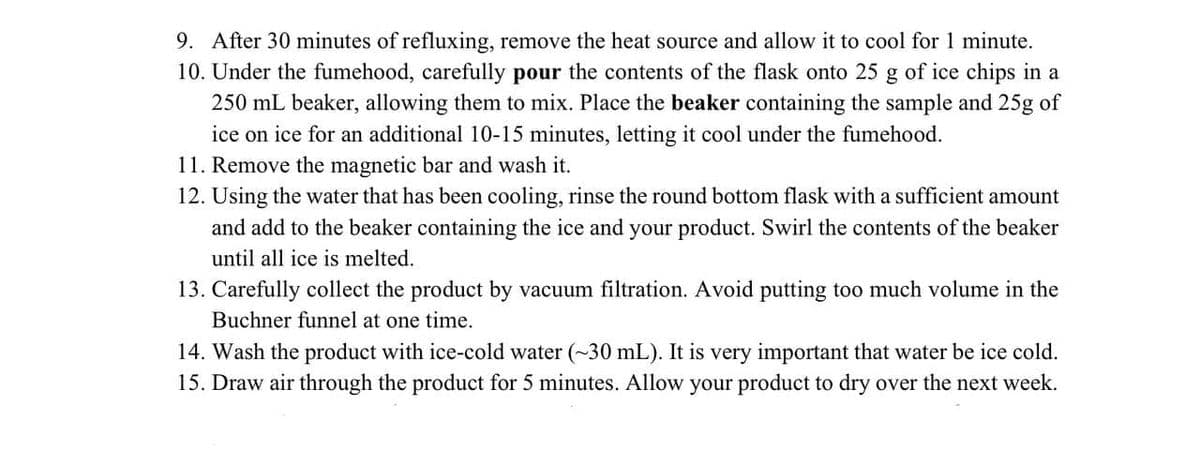a. Can you predict an undesirable side reaction that might occur using ethanol as a solvent that would not occur if we used THF as a solvent? b. Based on your knowledge of SN2 reactions, what would happen if we used 1-ethyl-2- naphthoxide instead of 2-naphthoxide? Explain.
a. Can you predict an undesirable side reaction that might occur using ethanol as a solvent that would not occur if we used THF as a solvent? b. Based on your knowledge of SN2 reactions, what would happen if we used 1-ethyl-2- naphthoxide instead of 2-naphthoxide? Explain.
Chapter81: Extractions, Separations, And Drying Agents
Section: Chapter Questions
Problem 5P
Related questions
Question
a. Can you predict an undesirable side reaction that might occur using ethanol as a solvent that would not occur if we used THF as a solvent?
b. Based on your knowledge of SN2 reactions, what would happen if we used 1-ethyl-2- naphthoxide instead of 2-naphthoxide? Explain.

Transcribed Image Text:Procedure:
1. Collect a small sample of 2-naphthol in a capillary tube. Label and store it for experiment
4. Reweigh the leftover 2-naphthol; use this mass in your calculations for this lab.
2. Set up
reflux
apparatus.
3. To a flat-bottomed round bottom flask, add ~0.56 g (14.0 mmol) of NaOH (about 5 pellets)
and the 2- naphthol through a powder funnel.
Note: If you have less than 0.5 g of 2 naphthol extracted, see one of the TAs. Do not use
more than 1.0g of 2-naphthol. If you have more than 1.0g, set the excess quantity aside.
4. Add 20 mL of ethanol (EtOH) and a magnetic stir bar to the flask.
5. Reflux the solution for 30 minutes or until all the solids have dissolved. Reflux heat should
be adjusted so there is a 1 drop/second rate from the condenser. Reflux should be conducted
on a hot plate with magnetic stirring: the hot plate can be set at 345 with the rpm at 800.
Note: The round bottom flask should be placed as close as possible to the hot plate but the
two should NOT make contact.
6. Once all solids have dissolved, remove the heat source and allow the solution to cool
slightly. Remove the reflux condenser (make sure the solution has stopped boiling
BEFORE you remove the condenser) and add 1.0 mL of 1-bromobutane (8.8 mmol) to the
flask.
7. Replace the condenser and reflux for an additional 30 minutes
8. While the solution is refluxing, prepare the following:
a. Vacuum filtration apparatus with a Buchner Funnel
b. Place 100 mL of water in an ice bath for later use.
c. Obtain the masses of recrystallized benzoic acid and 1,4 dimethoxybenzene
d. Right before the reflux is about to end, place 25 g of ice in a 250 mL beaker.

Transcribed Image Text:9. After 30 minutes of refluxing, remove the heat source and allow it to cool for 1 minute.
10. Under the fumehood, carefully pour the contents of the flask onto 25 g of ice chips in a
250 mL beaker, allowing them to mix. Place the beaker containing the sample and 25g of
ice on ice for an additional 10-15 minutes, letting it cool under the fumehood.
11. Remove the magnetic bar and wash it.
12. Using the water that has been cooling, rinse the round bottom flask with a sufficient amount
and add to the beaker containing the ice and your product. Swirl the contents of the beaker
until all ice is melted.
13. Carefully collect the product by vacuum filtration. Avoid putting too much volume in the
Buchner funnel at one time.
14. Wash the product with ice-cold water (~30 mL). It is very important that water be ice cold.
15. Draw air through the product for 5 minutes. Allow your product to dry over the next week.
Expert Solution
This question has been solved!
Explore an expertly crafted, step-by-step solution for a thorough understanding of key concepts.
This is a popular solution!
Trending now
This is a popular solution!
Step by step
Solved in 2 steps with 1 images

Knowledge Booster
Learn more about
Need a deep-dive on the concept behind this application? Look no further. Learn more about this topic, chemistry and related others by exploring similar questions and additional content below.Recommended textbooks for you

EBK A SMALL SCALE APPROACH TO ORGANIC L
Chemistry
ISBN:
9781305446021
Author:
Lampman
Publisher:
CENGAGE LEARNING - CONSIGNMENT

Chemical Principles in the Laboratory
Chemistry
ISBN:
9781305264434
Author:
Emil Slowinski, Wayne C. Wolsey, Robert Rossi
Publisher:
Brooks Cole

EBK A SMALL SCALE APPROACH TO ORGANIC L
Chemistry
ISBN:
9781305446021
Author:
Lampman
Publisher:
CENGAGE LEARNING - CONSIGNMENT

Chemical Principles in the Laboratory
Chemistry
ISBN:
9781305264434
Author:
Emil Slowinski, Wayne C. Wolsey, Robert Rossi
Publisher:
Brooks Cole